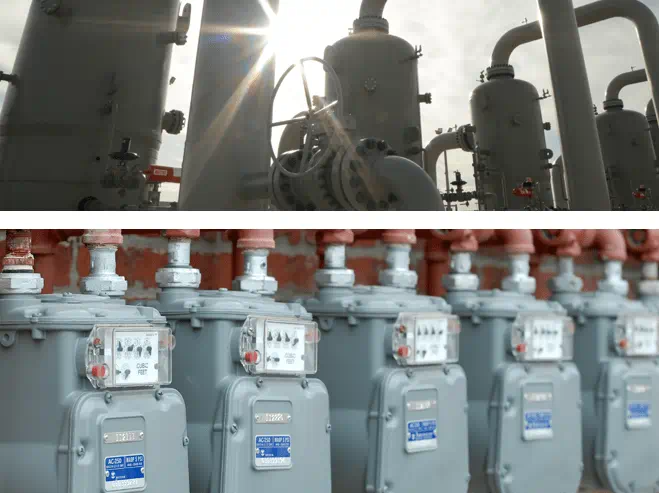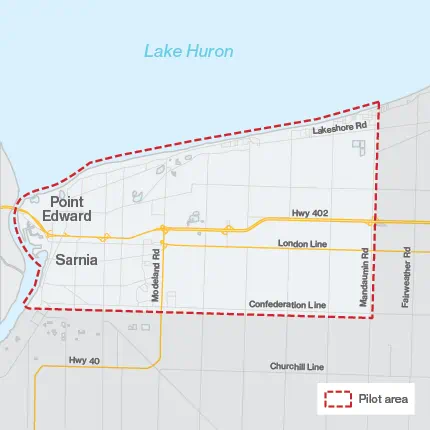Southern Lake Huron Pilot Project
Learn more about the project and the Integrated Resource Planning process below.
About the project
Enbridge Gas has submitted a proposal to the Ontario Energy Board to run a pilot project for homes and businesses of Enbridge Gas customers within the City of Sarnia and the Village of Point Edward in the County of Lambton to better understand the impacts that enhanced targeted energy efficiency (ETEE) and demand response (DR) Integrated Resource Planning alternatives (IRPA) have on reducing the natural gas system’s peak period demand.
Key objectives from this pilot are to:
- Develop an understanding of how to design, deploy and evaluate ETEE and DR programs.
- Gain insight into how ETEE measures and DR programs impact peak period demand.
Participation in the pilot programs will provide us with the data and insight that will inform future system planning and support our move towards net zero goals.
If approved, Enbridge will launch further community engagement and begin delivery of the programs. Updates will be posted here on this webpage as well as communicated to those who have signed up for updates via our website.
The Southern Lake Huron Integrated Resource Planning (IRP) pilot project area is unique in that most of the system is already equipped with meter reading technology which allows for data to be collected from customer’ meters, providing feedback on peak hour demand.
What's new
The Southern Lake Huron Pilot Project has been revised to reflect recent updates to Enbridge Gas’s 10-year capital forecast.
Our original application focused on a relatively narrow area that included a portion of City of Sarnia and Plympton-Wyoming, where the pilot area was largely defined by an area of influence impacted by the system need. A recent update to the system model has indicated the system need is no longer forecasted within our 10-year capital plan, which allows us to update the pilot area in a way that optimizes and expands the implementation of the pilot. The new pilot area will now target all of the City of Sarnia and Village of Point Edward with all demand-side alternatives.
The updated project will include residential and commercial energy efficiency programming (inclusive of advanced technologies and residential electrification measures) and demand response programming.
We will use advanced meter reading technology already in place to reduce costs and leverage existing infrastructure to study the impact of these programs.
For the latest updates, check out the link to the OEB filing below.
Why we're doing it
The pilot's purpose is to test and better understand the impacts that enhanced targeted energy efficiency (ETEE) and demand response have on reducing the natural gas system’s peak period demand.
ETEE involves offering targeted energy efficiency programs that support a reduction in peak period natural gas demand. While traditional energy efficiency programs have been in place for some time, using them to reduce peak demand requires more investigation. This pilot also aims to better understand how to design, deploy and evaluate ETEE programs.
The demand response program will provide residential customers, with natural gas central heating systems controlled by an eligible Wi-Fi-connected smart thermostat, with an incentive to enroll to allow their smart thermostat to be set back a few degrees by Enbridge Gas during peak demand response events in the winter heating season.
Impact
Our pilot projects have been designed to minimize disruption in our communities. Automated meter reading (AMR) technology is already installed on the majority of customer meters, which allows us to collect hourly usage data. This will help us better understand how enhanced energy efficiency and demand response programs impact peak natural gas demand.
Collecting hourly data from meters equipped with AMR technology will not disrupt your service, nor will there be any additional charges on your bill.
The pilot design will offer a range of our enhanced energy efficiency and demand response programs, so be sure to check back for more information.
Benefits
This pilot project represents an opportunity for your community to participate in the energy transition in Ontario. The learning's from this project will lead to better decision making, more informed system development and will shape asset management for years to come.
The pilot will also benefit participating customers in the community through enhanced energy efficiency programming that can help reduce consumption and potentially lower energy bills.
Community outreach
If the application is approved we will be reaching out to the community with more details and opportunities for residents to get involved. Sign up for updates to make sure you're included.
Regulatory updates
We have filed our application for approval of costs and the accounting treatment of costs, associated with the Integrated Resource Planning pilot project.
What is IRP?
Integrated Resource Planning (IRP) is a natural gas planning strategy and process1. Through the IRP process, we forecast what energy demand will look like, determine whether a traditional pipe project or an alternative will meet the energy need, and then lay out a roadmap for how we’ll manage it. As part of this process, we gather input and feedback from communities on what matters most.
Non-pipeline alternatives can include:
- Demand side alternative:
- Lowering or shifting energy use through energy efficiency programs such as ETEE programs or demand response (DR) programs.
- Supply side alternative:
- Delivering more energy without adding new pipeline using compressed natural gas (CNG) or liquified natural gas (LNG).
- Displacing conventional natural gas with carbon neutral renewable natural gas and hydrogen.
- Adding supply through upstream deliveries.
Alternatives can be implemented individually or in combination to meet the system need cost effectively and within the required timeframe.
1 IRP Framework was published by the OEB on July 22, 2021.

How Enbridge Gas is Supporting a Net Zero Future
Energy warms our homes, powers our vehicles and helps produce and move the goods we use every day. As our climate changes, energy systems are evolving, working together to meet our future energy needs sustainably.
For us, innovation comes naturally. We’re collaborating to advance new green technologies to fuel transportation, heat buildings and power industry. We’re introducing new renewable fuels and finding practical ways to use less energy.
The most cost-effective and resilient path to net-zero*Net zero means reducing GHG emissions to as close to zero as possible, then balancing any remaining emissions with an equivalent amount of carbon removal through environmental actions and innovative technology.
https://www.canada.ca/en/services/environment/weather/climatechange/climate-plan/net-zero-emissions-2050.html emissions requires electric and gas systems to work together. This includes increased electrification of building heat, personal and light-duty vehicles; greening the gas supply with renewable natural gas and hydrogen; and powering industry with hydrogen and blended natural gas, combined with carbon capture.
This collaborative approach will:
- Reliably meet our energy needs, even on the coldest days.
- Meet the energy needs of industries like concrete and steel production, and heavy transportation that can’t be practically electrified.
- Minimize costs for energy consumers.
- Provide consumers flexibility to make choices on their path to net zero.
Energy sources
Transportation
Building heating and cooling
Industrial processes

Have your say
We want to hear what matters most to you. Take a few moments to share your thoughts on projects and priorities in your community.









